Comprehensive Analysis of the Australian Dairy Industry Supply Chain
VerifiedAdded on 2020/03/28
|9
|1700
|42
Report
AI Summary
This report provides a comprehensive analysis of the Australian dairy industry supply chain. It begins with an introduction to the industry, highlighting its significance in global dairy production and its export performance. The report then delves into the industry's structure, including its two primary markets (domestic and international) and the key players within each. A detailed SWOT analysis is presented, outlining the strengths, weaknesses, opportunities, and threats facing the industry. The challenges discussed include fluctuating market prices, climatic conditions, and urbanization. The opportunities section focuses on the growing demand for dairy products in both domestic and international markets. The report concludes with recommendations for improving the supply chain, such as the need for cooperatives and the implementation of supply chain coordination theories to stabilize prices and enhance production. References to relevant academic research are included to support the analysis.
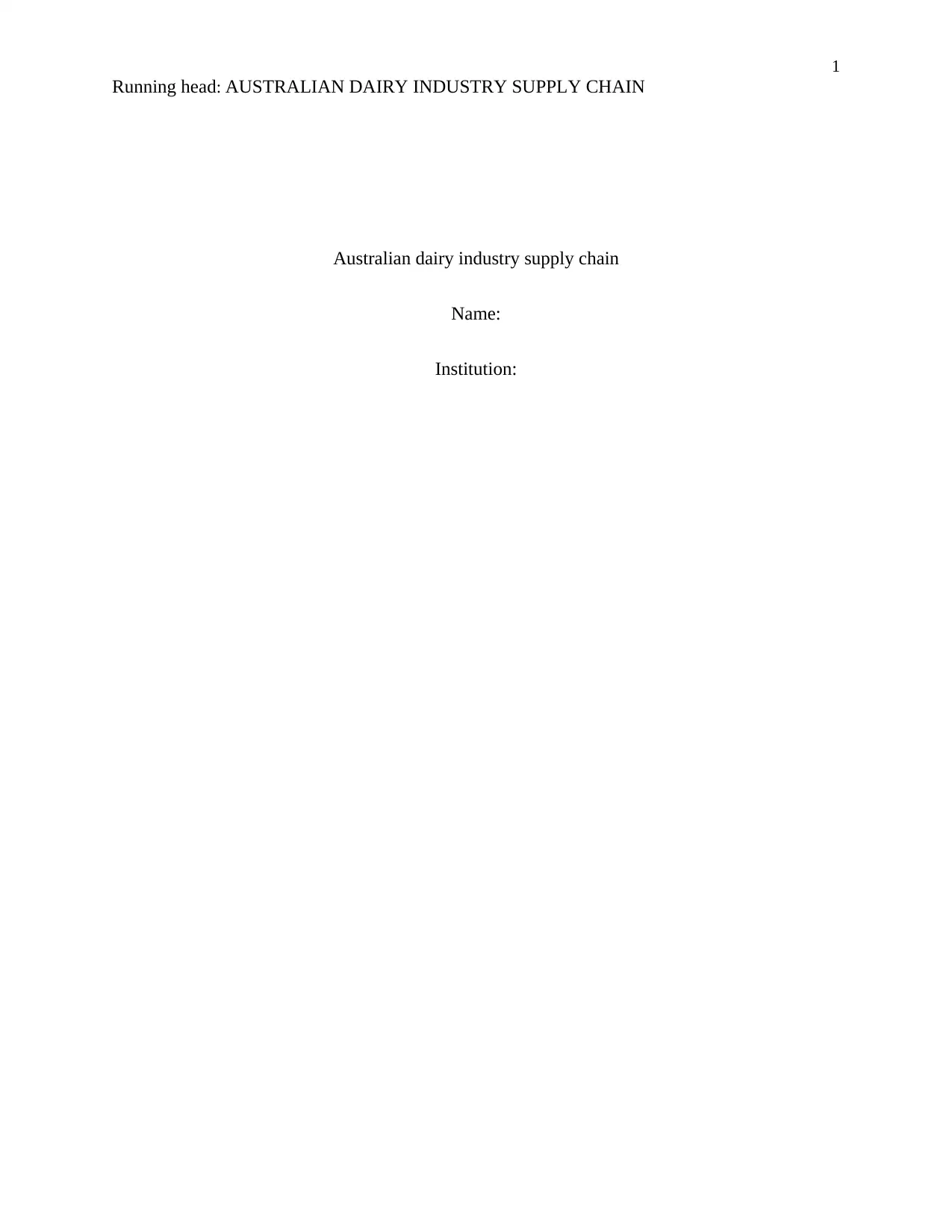
1
Running head: AUSTRALIAN DAIRY INDUSTRY SUPPLY CHAIN
Australian dairy industry supply chain
Name:
Institution:
Running head: AUSTRALIAN DAIRY INDUSTRY SUPPLY CHAIN
Australian dairy industry supply chain
Name:
Institution:
Paraphrase This Document
Need a fresh take? Get an instant paraphrase of this document with our AI Paraphraser
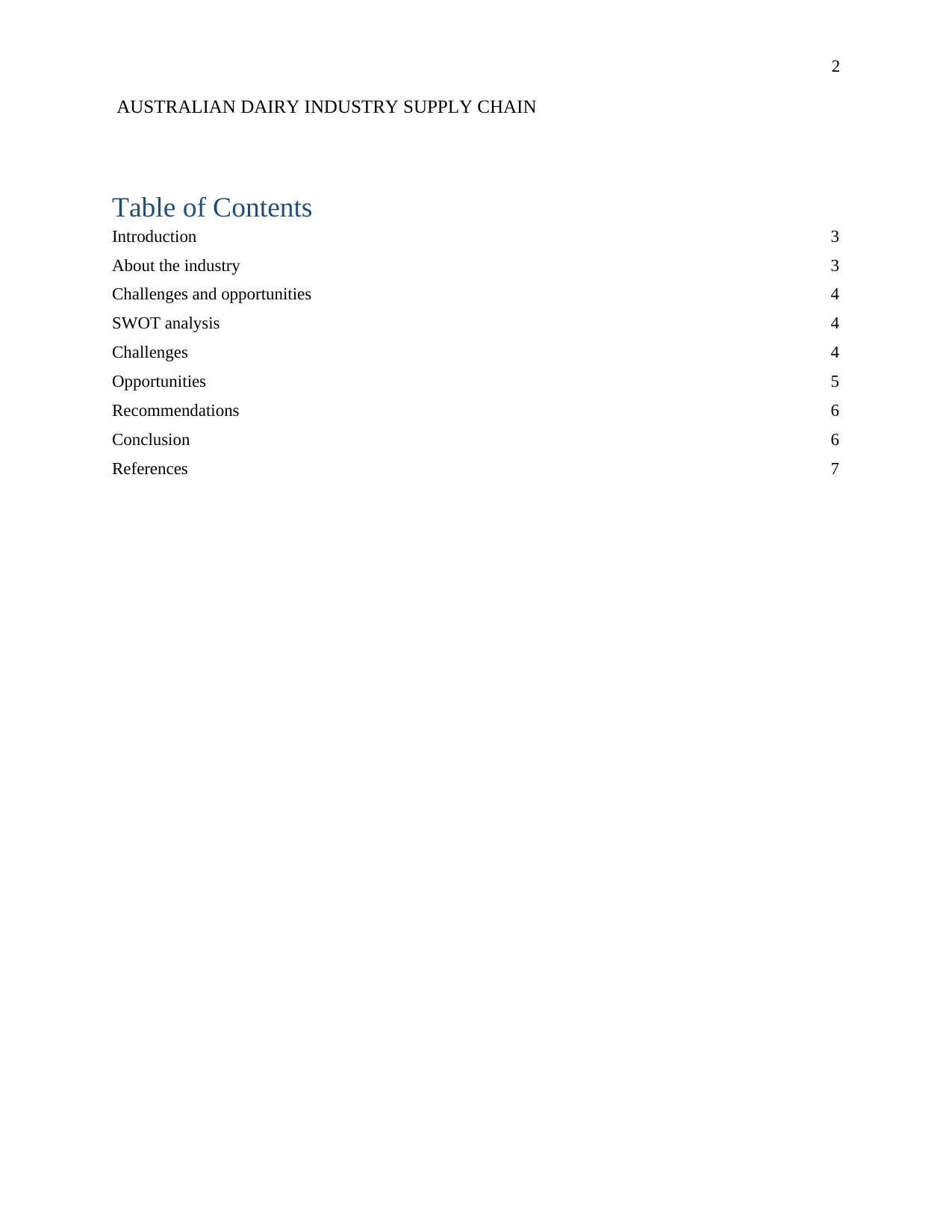
2
AUSTRALIAN DAIRY INDUSTRY SUPPLY CHAIN
Table of Contents
Introduction 3
About the industry 3
Challenges and opportunities 4
SWOT analysis 4
Challenges 4
Opportunities 5
Recommendations 6
Conclusion 6
References 7
AUSTRALIAN DAIRY INDUSTRY SUPPLY CHAIN
Table of Contents
Introduction 3
About the industry 3
Challenges and opportunities 4
SWOT analysis 4
Challenges 4
Opportunities 5
Recommendations 6
Conclusion 6
References 7
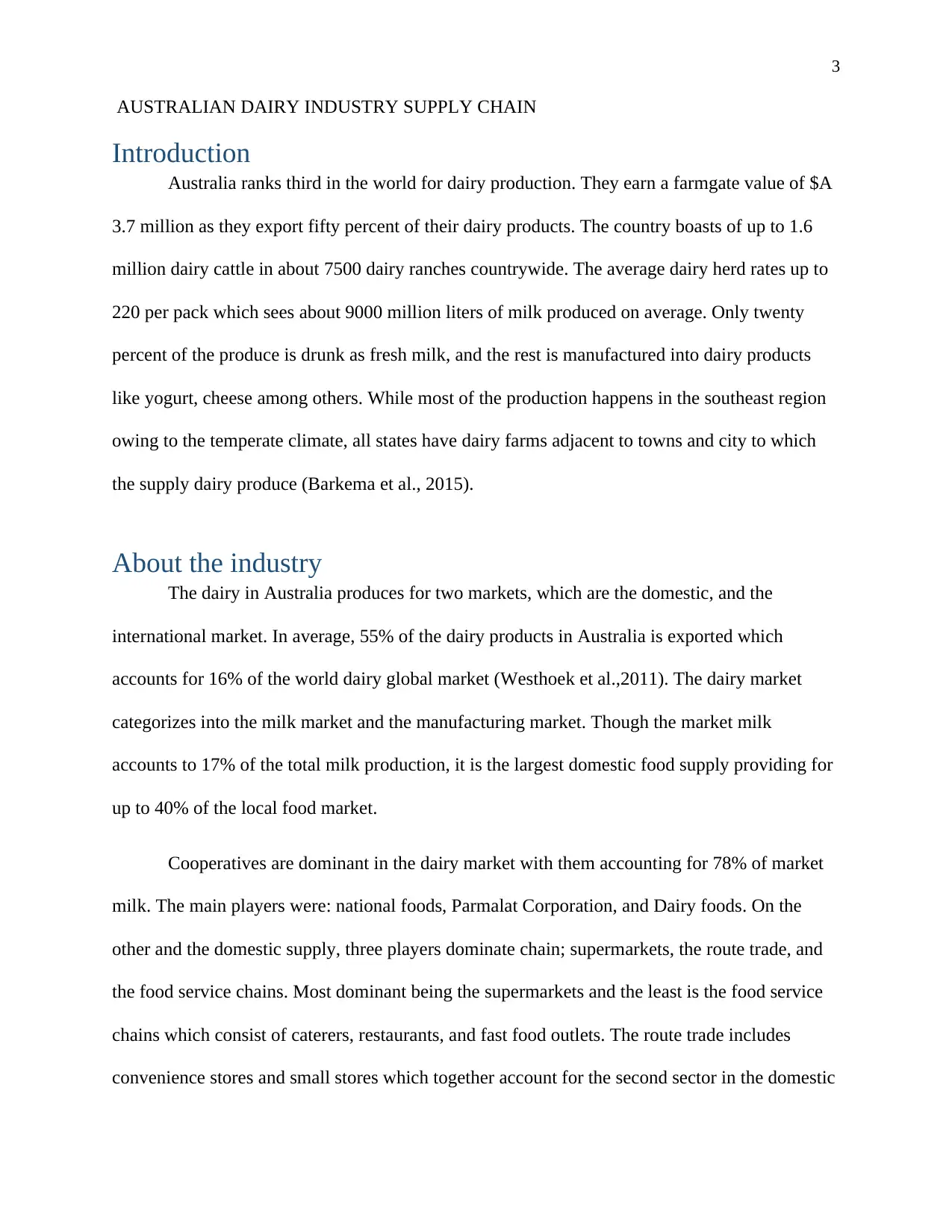
3
AUSTRALIAN DAIRY INDUSTRY SUPPLY CHAIN
Introduction
Australia ranks third in the world for dairy production. They earn a farmgate value of $A
3.7 million as they export fifty percent of their dairy products. The country boasts of up to 1.6
million dairy cattle in about 7500 dairy ranches countrywide. The average dairy herd rates up to
220 per pack which sees about 9000 million liters of milk produced on average. Only twenty
percent of the produce is drunk as fresh milk, and the rest is manufactured into dairy products
like yogurt, cheese among others. While most of the production happens in the southeast region
owing to the temperate climate, all states have dairy farms adjacent to towns and city to which
the supply dairy produce (Barkema et al., 2015).
About the industry
The dairy in Australia produces for two markets, which are the domestic, and the
international market. In average, 55% of the dairy products in Australia is exported which
accounts for 16% of the world dairy global market (Westhoek et al.,2011). The dairy market
categorizes into the milk market and the manufacturing market. Though the market milk
accounts to 17% of the total milk production, it is the largest domestic food supply providing for
up to 40% of the local food market.
Cooperatives are dominant in the dairy market with them accounting for 78% of market
milk. The main players were: national foods, Parmalat Corporation, and Dairy foods. On the
other and the domestic supply, three players dominate chain; supermarkets, the route trade, and
the food service chains. Most dominant being the supermarkets and the least is the food service
chains which consist of caterers, restaurants, and fast food outlets. The route trade includes
convenience stores and small stores which together account for the second sector in the domestic
AUSTRALIAN DAIRY INDUSTRY SUPPLY CHAIN
Introduction
Australia ranks third in the world for dairy production. They earn a farmgate value of $A
3.7 million as they export fifty percent of their dairy products. The country boasts of up to 1.6
million dairy cattle in about 7500 dairy ranches countrywide. The average dairy herd rates up to
220 per pack which sees about 9000 million liters of milk produced on average. Only twenty
percent of the produce is drunk as fresh milk, and the rest is manufactured into dairy products
like yogurt, cheese among others. While most of the production happens in the southeast region
owing to the temperate climate, all states have dairy farms adjacent to towns and city to which
the supply dairy produce (Barkema et al., 2015).
About the industry
The dairy in Australia produces for two markets, which are the domestic, and the
international market. In average, 55% of the dairy products in Australia is exported which
accounts for 16% of the world dairy global market (Westhoek et al.,2011). The dairy market
categorizes into the milk market and the manufacturing market. Though the market milk
accounts to 17% of the total milk production, it is the largest domestic food supply providing for
up to 40% of the local food market.
Cooperatives are dominant in the dairy market with them accounting for 78% of market
milk. The main players were: national foods, Parmalat Corporation, and Dairy foods. On the
other and the domestic supply, three players dominate chain; supermarkets, the route trade, and
the food service chains. Most dominant being the supermarkets and the least is the food service
chains which consist of caterers, restaurants, and fast food outlets. The route trade includes
convenience stores and small stores which together account for the second sector in the domestic
⊘ This is a preview!⊘
Do you want full access?
Subscribe today to unlock all pages.

Trusted by 1+ million students worldwide
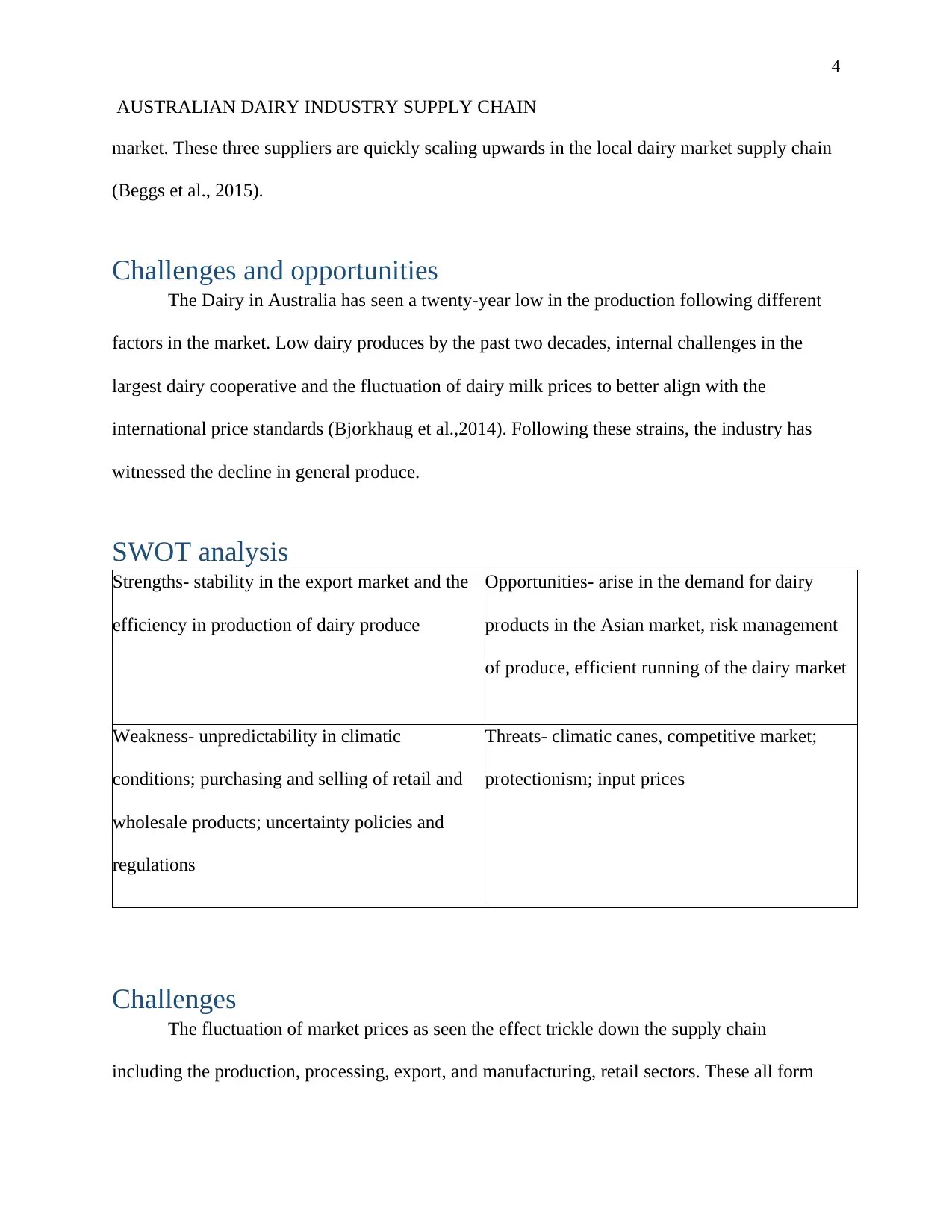
4
AUSTRALIAN DAIRY INDUSTRY SUPPLY CHAIN
market. These three suppliers are quickly scaling upwards in the local dairy market supply chain
(Beggs et al., 2015).
Challenges and opportunities
The Dairy in Australia has seen a twenty-year low in the production following different
factors in the market. Low dairy produces by the past two decades, internal challenges in the
largest dairy cooperative and the fluctuation of dairy milk prices to better align with the
international price standards (Bjorkhaug et al.,2014). Following these strains, the industry has
witnessed the decline in general produce.
SWOT analysis
Strengths- stability in the export market and the
efficiency in production of dairy produce
Opportunities- arise in the demand for dairy
products in the Asian market, risk management
of produce, efficient running of the dairy market
Weakness- unpredictability in climatic
conditions; purchasing and selling of retail and
wholesale products; uncertainty policies and
regulations
Threats- climatic canes, competitive market;
protectionism; input prices
Challenges
The fluctuation of market prices as seen the effect trickle down the supply chain
including the production, processing, export, and manufacturing, retail sectors. These all form
AUSTRALIAN DAIRY INDUSTRY SUPPLY CHAIN
market. These three suppliers are quickly scaling upwards in the local dairy market supply chain
(Beggs et al., 2015).
Challenges and opportunities
The Dairy in Australia has seen a twenty-year low in the production following different
factors in the market. Low dairy produces by the past two decades, internal challenges in the
largest dairy cooperative and the fluctuation of dairy milk prices to better align with the
international price standards (Bjorkhaug et al.,2014). Following these strains, the industry has
witnessed the decline in general produce.
SWOT analysis
Strengths- stability in the export market and the
efficiency in production of dairy produce
Opportunities- arise in the demand for dairy
products in the Asian market, risk management
of produce, efficient running of the dairy market
Weakness- unpredictability in climatic
conditions; purchasing and selling of retail and
wholesale products; uncertainty policies and
regulations
Threats- climatic canes, competitive market;
protectionism; input prices
Challenges
The fluctuation of market prices as seen the effect trickle down the supply chain
including the production, processing, export, and manufacturing, retail sectors. These all form
Paraphrase This Document
Need a fresh take? Get an instant paraphrase of this document with our AI Paraphraser
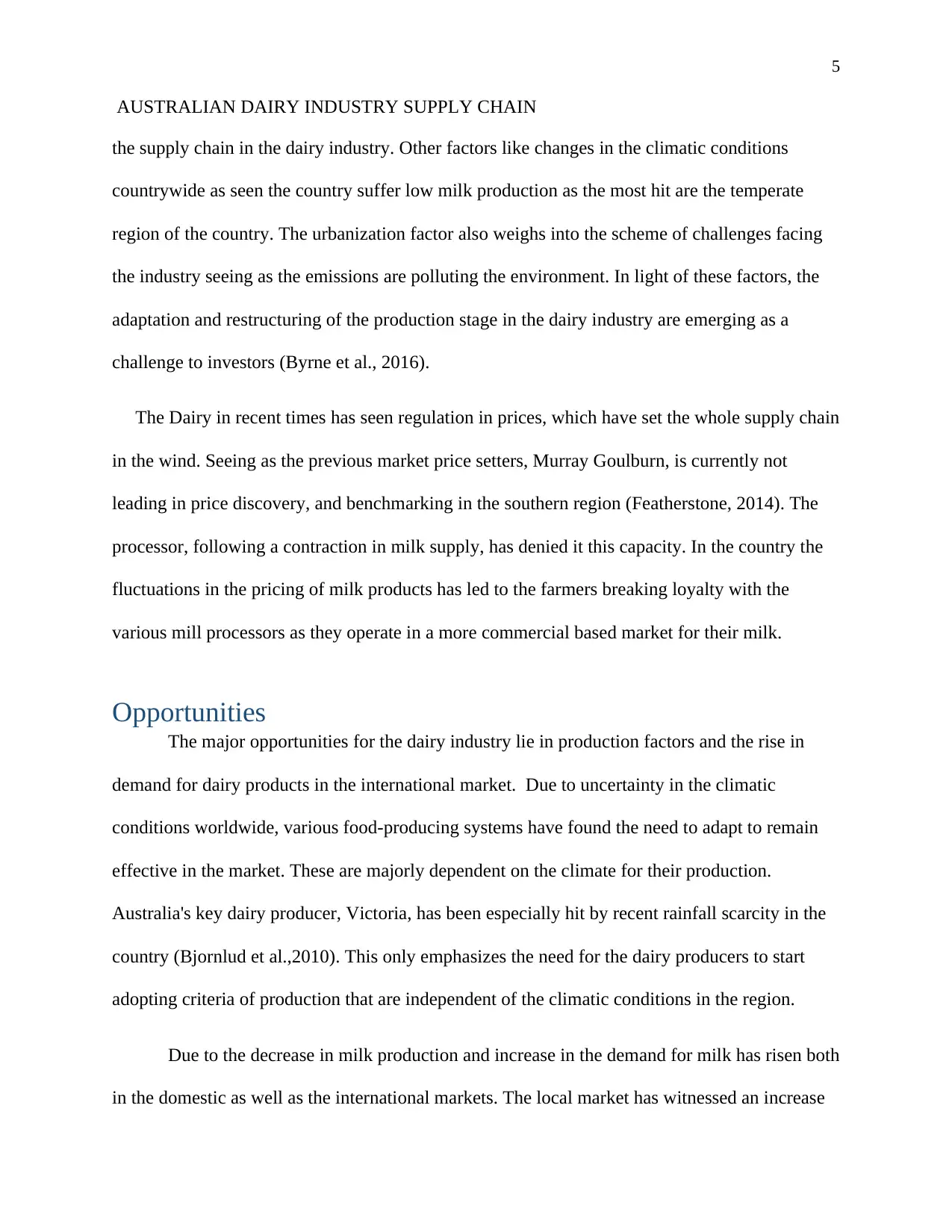
5
AUSTRALIAN DAIRY INDUSTRY SUPPLY CHAIN
the supply chain in the dairy industry. Other factors like changes in the climatic conditions
countrywide as seen the country suffer low milk production as the most hit are the temperate
region of the country. The urbanization factor also weighs into the scheme of challenges facing
the industry seeing as the emissions are polluting the environment. In light of these factors, the
adaptation and restructuring of the production stage in the dairy industry are emerging as a
challenge to investors (Byrne et al., 2016).
The Dairy in recent times has seen regulation in prices, which have set the whole supply chain
in the wind. Seeing as the previous market price setters, Murray Goulburn, is currently not
leading in price discovery, and benchmarking in the southern region (Featherstone, 2014). The
processor, following a contraction in milk supply, has denied it this capacity. In the country the
fluctuations in the pricing of milk products has led to the farmers breaking loyalty with the
various mill processors as they operate in a more commercial based market for their milk.
Opportunities
The major opportunities for the dairy industry lie in production factors and the rise in
demand for dairy products in the international market. Due to uncertainty in the climatic
conditions worldwide, various food-producing systems have found the need to adapt to remain
effective in the market. These are majorly dependent on the climate for their production.
Australia's key dairy producer, Victoria, has been especially hit by recent rainfall scarcity in the
country (Bjornlud et al.,2010). This only emphasizes the need for the dairy producers to start
adopting criteria of production that are independent of the climatic conditions in the region.
Due to the decrease in milk production and increase in the demand for milk has risen both
in the domestic as well as the international markets. The local market has witnessed an increase
AUSTRALIAN DAIRY INDUSTRY SUPPLY CHAIN
the supply chain in the dairy industry. Other factors like changes in the climatic conditions
countrywide as seen the country suffer low milk production as the most hit are the temperate
region of the country. The urbanization factor also weighs into the scheme of challenges facing
the industry seeing as the emissions are polluting the environment. In light of these factors, the
adaptation and restructuring of the production stage in the dairy industry are emerging as a
challenge to investors (Byrne et al., 2016).
The Dairy in recent times has seen regulation in prices, which have set the whole supply chain
in the wind. Seeing as the previous market price setters, Murray Goulburn, is currently not
leading in price discovery, and benchmarking in the southern region (Featherstone, 2014). The
processor, following a contraction in milk supply, has denied it this capacity. In the country the
fluctuations in the pricing of milk products has led to the farmers breaking loyalty with the
various mill processors as they operate in a more commercial based market for their milk.
Opportunities
The major opportunities for the dairy industry lie in production factors and the rise in
demand for dairy products in the international market. Due to uncertainty in the climatic
conditions worldwide, various food-producing systems have found the need to adapt to remain
effective in the market. These are majorly dependent on the climate for their production.
Australia's key dairy producer, Victoria, has been especially hit by recent rainfall scarcity in the
country (Bjornlud et al.,2010). This only emphasizes the need for the dairy producers to start
adopting criteria of production that are independent of the climatic conditions in the region.
Due to the decrease in milk production and increase in the demand for milk has risen both
in the domestic as well as the international markets. The local market has witnessed an increase
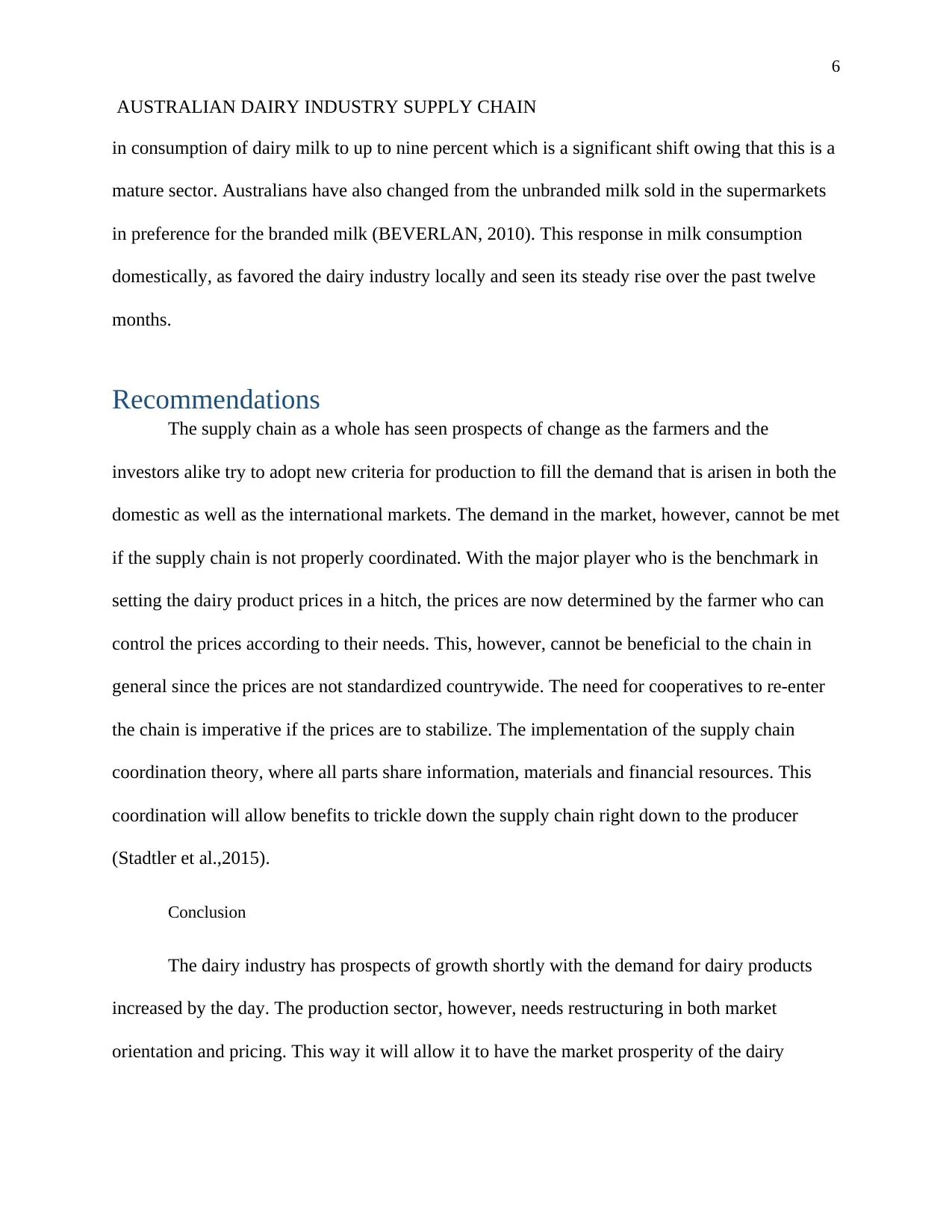
6
AUSTRALIAN DAIRY INDUSTRY SUPPLY CHAIN
in consumption of dairy milk to up to nine percent which is a significant shift owing that this is a
mature sector. Australians have also changed from the unbranded milk sold in the supermarkets
in preference for the branded milk (BEVERLAN, 2010). This response in milk consumption
domestically, as favored the dairy industry locally and seen its steady rise over the past twelve
months.
Recommendations
The supply chain as a whole has seen prospects of change as the farmers and the
investors alike try to adopt new criteria for production to fill the demand that is arisen in both the
domestic as well as the international markets. The demand in the market, however, cannot be met
if the supply chain is not properly coordinated. With the major player who is the benchmark in
setting the dairy product prices in a hitch, the prices are now determined by the farmer who can
control the prices according to their needs. This, however, cannot be beneficial to the chain in
general since the prices are not standardized countrywide. The need for cooperatives to re-enter
the chain is imperative if the prices are to stabilize. The implementation of the supply chain
coordination theory, where all parts share information, materials and financial resources. This
coordination will allow benefits to trickle down the supply chain right down to the producer
(Stadtler et al.,2015).
Conclusion
The dairy industry has prospects of growth shortly with the demand for dairy products
increased by the day. The production sector, however, needs restructuring in both market
orientation and pricing. This way it will allow it to have the market prosperity of the dairy
AUSTRALIAN DAIRY INDUSTRY SUPPLY CHAIN
in consumption of dairy milk to up to nine percent which is a significant shift owing that this is a
mature sector. Australians have also changed from the unbranded milk sold in the supermarkets
in preference for the branded milk (BEVERLAN, 2010). This response in milk consumption
domestically, as favored the dairy industry locally and seen its steady rise over the past twelve
months.
Recommendations
The supply chain as a whole has seen prospects of change as the farmers and the
investors alike try to adopt new criteria for production to fill the demand that is arisen in both the
domestic as well as the international markets. The demand in the market, however, cannot be met
if the supply chain is not properly coordinated. With the major player who is the benchmark in
setting the dairy product prices in a hitch, the prices are now determined by the farmer who can
control the prices according to their needs. This, however, cannot be beneficial to the chain in
general since the prices are not standardized countrywide. The need for cooperatives to re-enter
the chain is imperative if the prices are to stabilize. The implementation of the supply chain
coordination theory, where all parts share information, materials and financial resources. This
coordination will allow benefits to trickle down the supply chain right down to the producer
(Stadtler et al.,2015).
Conclusion
The dairy industry has prospects of growth shortly with the demand for dairy products
increased by the day. The production sector, however, needs restructuring in both market
orientation and pricing. This way it will allow it to have the market prosperity of the dairy
⊘ This is a preview!⊘
Do you want full access?
Subscribe today to unlock all pages.

Trusted by 1+ million students worldwide
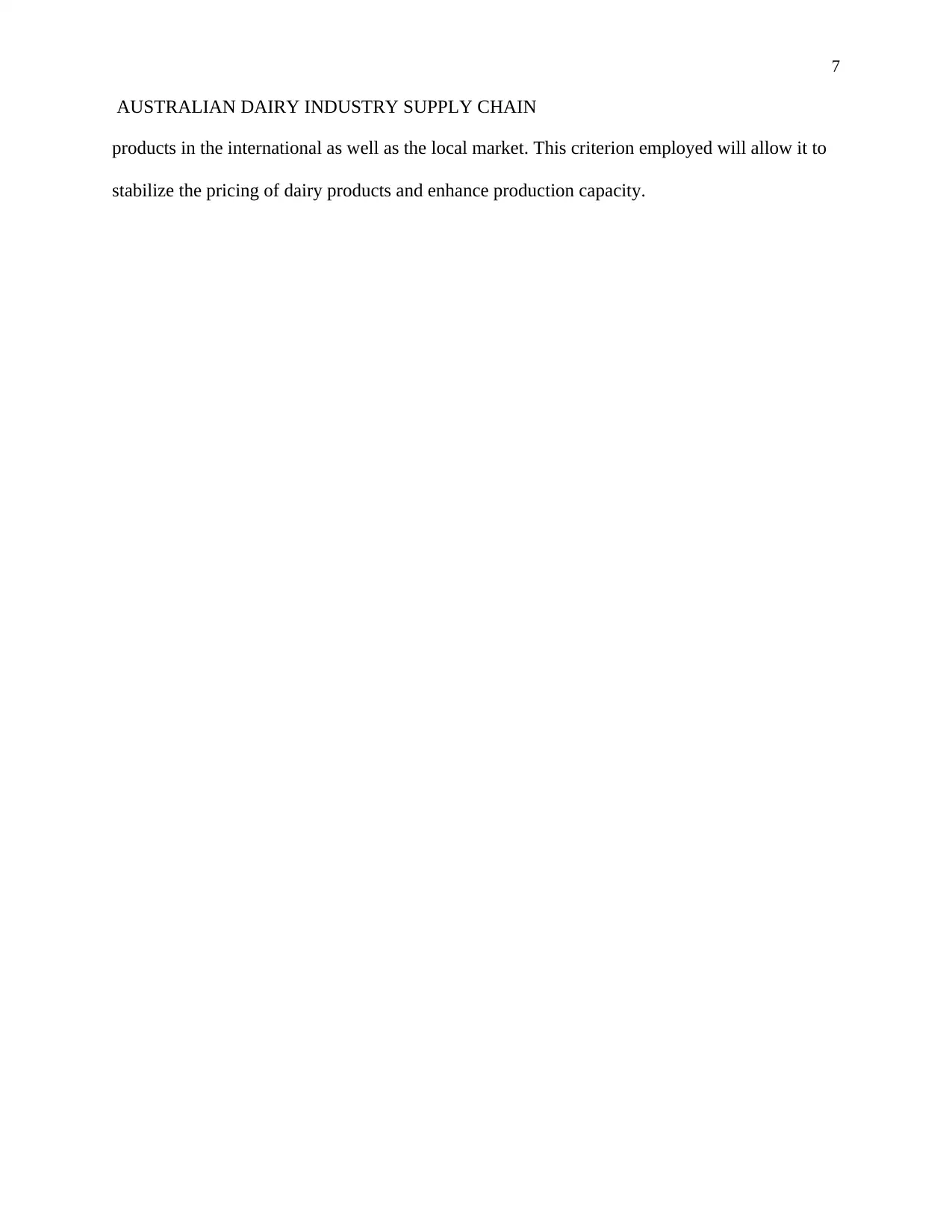
7
AUSTRALIAN DAIRY INDUSTRY SUPPLY CHAIN
products in the international as well as the local market. This criterion employed will allow it to
stabilize the pricing of dairy products and enhance production capacity.
AUSTRALIAN DAIRY INDUSTRY SUPPLY CHAIN
products in the international as well as the local market. This criterion employed will allow it to
stabilize the pricing of dairy products and enhance production capacity.
Paraphrase This Document
Need a fresh take? Get an instant paraphrase of this document with our AI Paraphraser
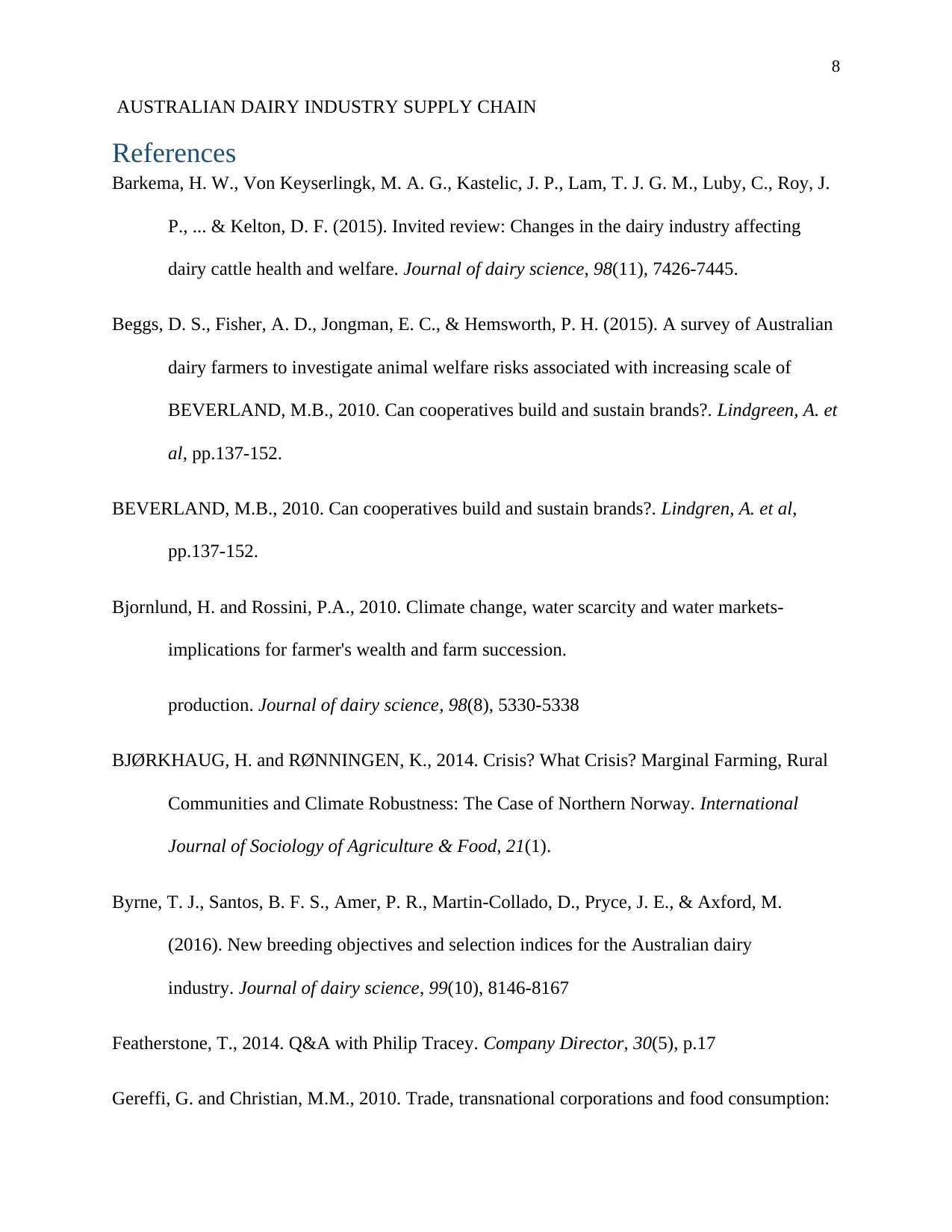
8
AUSTRALIAN DAIRY INDUSTRY SUPPLY CHAIN
References
Barkema, H. W., Von Keyserlingk, M. A. G., Kastelic, J. P., Lam, T. J. G. M., Luby, C., Roy, J.
P., ... & Kelton, D. F. (2015). Invited review: Changes in the dairy industry affecting
dairy cattle health and welfare. Journal of dairy science, 98(11), 7426-7445.
Beggs, D. S., Fisher, A. D., Jongman, E. C., & Hemsworth, P. H. (2015). A survey of Australian
dairy farmers to investigate animal welfare risks associated with increasing scale of
BEVERLAND, M.B., 2010. Can cooperatives build and sustain brands?. Lindgreen, A. et
al, pp.137-152.
BEVERLAND, M.B., 2010. Can cooperatives build and sustain brands?. Lindgren, A. et al,
pp.137-152.
Bjornlund, H. and Rossini, P.A., 2010. Climate change, water scarcity and water markets-
implications for farmer's wealth and farm succession.
production. Journal of dairy science, 98(8), 5330-5338
BJØRKHAUG, H. and RØNNINGEN, K., 2014. Crisis? What Crisis? Marginal Farming, Rural
Communities and Climate Robustness: The Case of Northern Norway. International
Journal of Sociology of Agriculture & Food, 21(1).
Byrne, T. J., Santos, B. F. S., Amer, P. R., Martin-Collado, D., Pryce, J. E., & Axford, M.
(2016). New breeding objectives and selection indices for the Australian dairy
industry. Journal of dairy science, 99(10), 8146-8167
Featherstone, T., 2014. Q&A with Philip Tracey. Company Director, 30(5), p.17
Gereffi, G. and Christian, M.M., 2010. Trade, transnational corporations and food consumption:
AUSTRALIAN DAIRY INDUSTRY SUPPLY CHAIN
References
Barkema, H. W., Von Keyserlingk, M. A. G., Kastelic, J. P., Lam, T. J. G. M., Luby, C., Roy, J.
P., ... & Kelton, D. F. (2015). Invited review: Changes in the dairy industry affecting
dairy cattle health and welfare. Journal of dairy science, 98(11), 7426-7445.
Beggs, D. S., Fisher, A. D., Jongman, E. C., & Hemsworth, P. H. (2015). A survey of Australian
dairy farmers to investigate animal welfare risks associated with increasing scale of
BEVERLAND, M.B., 2010. Can cooperatives build and sustain brands?. Lindgreen, A. et
al, pp.137-152.
BEVERLAND, M.B., 2010. Can cooperatives build and sustain brands?. Lindgren, A. et al,
pp.137-152.
Bjornlund, H. and Rossini, P.A., 2010. Climate change, water scarcity and water markets-
implications for farmer's wealth and farm succession.
production. Journal of dairy science, 98(8), 5330-5338
BJØRKHAUG, H. and RØNNINGEN, K., 2014. Crisis? What Crisis? Marginal Farming, Rural
Communities and Climate Robustness: The Case of Northern Norway. International
Journal of Sociology of Agriculture & Food, 21(1).
Byrne, T. J., Santos, B. F. S., Amer, P. R., Martin-Collado, D., Pryce, J. E., & Axford, M.
(2016). New breeding objectives and selection indices for the Australian dairy
industry. Journal of dairy science, 99(10), 8146-8167
Featherstone, T., 2014. Q&A with Philip Tracey. Company Director, 30(5), p.17
Gereffi, G. and Christian, M.M., 2010. Trade, transnational corporations and food consumption:

9
AUSTRALIAN DAIRY INDUSTRY SUPPLY CHAIN
Stadtler, H., 2015. Supply chain management: An overview. In Supply chain management and advanced
planning (pp. 3-28). Springer Berlin Heidelberg.A global value chain approach.
Westhoek, H., Rood, T., van den Berg, M., Janse, J., Nijdam, D., Reudink, M., Stehfest, E.,
Lesschen, J.P., Oenema, O. and Woltjer, G.B., 2011. The protein puzzle: the
consumption and production of meat, dairy, and fish in the European Union (No.
500166001). Netherlands Environmental Assessment Agency.
AUSTRALIAN DAIRY INDUSTRY SUPPLY CHAIN
Stadtler, H., 2015. Supply chain management: An overview. In Supply chain management and advanced
planning (pp. 3-28). Springer Berlin Heidelberg.A global value chain approach.
Westhoek, H., Rood, T., van den Berg, M., Janse, J., Nijdam, D., Reudink, M., Stehfest, E.,
Lesschen, J.P., Oenema, O. and Woltjer, G.B., 2011. The protein puzzle: the
consumption and production of meat, dairy, and fish in the European Union (No.
500166001). Netherlands Environmental Assessment Agency.
⊘ This is a preview!⊘
Do you want full access?
Subscribe today to unlock all pages.

Trusted by 1+ million students worldwide
1 out of 9
Related Documents
Your All-in-One AI-Powered Toolkit for Academic Success.
+13062052269
info@desklib.com
Available 24*7 on WhatsApp / Email
![[object Object]](/_next/static/media/star-bottom.7253800d.svg)
Unlock your academic potential
Copyright © 2020–2025 A2Z Services. All Rights Reserved. Developed and managed by ZUCOL.





